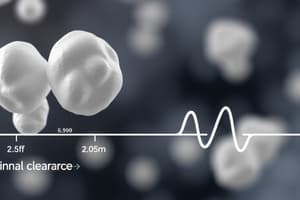Podcast
Questions and Answers
Assuming her last dose of the drug was Thursday evening and the drug half-life is 12 hours, when should the drug be about 97% gone?
Assuming her last dose of the drug was Thursday evening and the drug half-life is 12 hours, when should the drug be about 97% gone?
- Saturday AM
- can't tell without more information
- Saturday PM
- Sunday AM (correct)
- Friday PM
Why are some intravenous drugs delivered in one initial large 'loading dose' followed by smaller, regular doses?
Why are some intravenous drugs delivered in one initial large 'loading dose' followed by smaller, regular doses?
- to occupy all renal transporters to reduce elimination
- to occupy all CYP enzymes to reduce CYP effect
- to fill all albumin binding sites (correct)
- to stimulate all drug receptors for maximum initial response (correct)
- to occupy all Phase II enzymes to reduce elimination
The plasma protein albumin has its greatest effect on what aspect of pharmacokinetics?
The plasma protein albumin has its greatest effect on what aspect of pharmacokinetics?
- distribution (correct)
- metabolism
- absorption
- excretion
Which of the following drugs to control inflammation is preferred for patients who are at highest risk of bleeding stomach ulcers?
Which of the following drugs to control inflammation is preferred for patients who are at highest risk of bleeding stomach ulcers?
Patients with coronary artery disease are at risk of adverse cardiac events if they often take which of the following?
Patients with coronary artery disease are at risk of adverse cardiac events if they often take which of the following?
Flashcards are hidden until you start studying
Study Notes
Pharmacokinetics Basics
- Drug elimination follows a half-life concept; a drug is typically about 97% cleared after 5 half-lives.
- For a drug with a 12-hour half-life, effective clearance is approximately 60 hours after the last dose.
Antibiotic Allergy Response
- In cases of allergic reactions to antibiotics, switching to a different class is required.
- Recovery time can be estimated based on the drug's half-life; a patient may feel better by Sunday morning after stopping the drug on Friday.
Loading Dose Purpose
- A loading dose provides an immediate therapeutic effect when gradual dosing is insufficient.
- The purpose includes rapidly stimulating drug receptors, ensuring an effective response quickly.
- Loading doses help saturate protein binding sites, particularly albumin, ensuring steady-state concentration.
Role of Albumin in Pharmacokinetics
- Albumin significantly affects drug distribution, transporting fat-soluble drugs in the bloodstream.
- A majority of drugs (approximately 80%) bind to plasma proteins, impacting their metabolization and efficacy.
Processes in Pharmacokinetics
- Absorption: Drugs enter the bloodstream through various routes; factors affecting this include formulation and food interactions.
- Distribution: Bound drugs achieve an equilibrium across body compartments, with 20% remaining free for metabolism.
- Metabolism: The liver metabolizes most drugs using Cytochrome P450 enzymes, affected by age, genetics, and drug interactions.
- Excretion: Primarily occurs through kidneys; renal dysfunction and age can greatly impact drug clearance.
COX-2 Inhibitors and Gastrointestinal Safety
- Celecoxib is preferred for managing inflammation in patients at high risk of gastric ulcers due to its selective inhibition of COX-2.
- Traditional NSAIDs inhibit both COX-1 (protective) and COX-2 (inflammatory) enzymes, increasing ulcer risk.
Ibuprofen and Cardiovascular Risks
- Frequent use of ibuprofen poses risks of adverse cardiac events, especially in patients with coronary artery disease.
- The medication’s effect on prostaglandins can lead to complications in cardiovascular health.
Studying That Suits You
Use AI to generate personalized quizzes and flashcards to suit your learning preferences.




